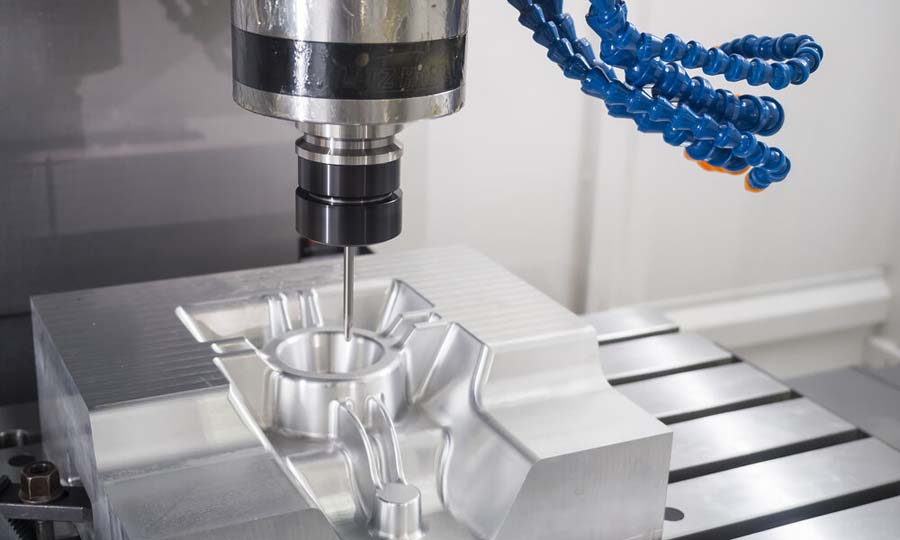In today’s manufacturing industry, selecting the appropriate machining method for small-batch parts is crucial for businesses. Unlike mass production, small-batch machining requires a delicate balance between cost, efficiency, and quality. Choosing the right processing method is essential to ensure part accuracy, performance, and compliance with project budget and timeline requirements. The following will explore the key factors to consider when selecting a machining method for small-batch parts and introduce common processing techniques.
Key Considerations
Complexity of the Parts
If a part features intricate geometries, such as fine internal structures, irregular curved surfaces, or tiny features, traditional machining methods may struggle to meet the requirements. For instance, CNC machining is often a better choice for parts with complex internal flow channels. With precise programming control over tool movement, CNC machining enables the accurate processing of complex shapes. On the other hand, for simpler flat parts, more straightforward and efficient methods like stamping or laser cutting may be preferable.
Precision Requirements
Different machining methods offer varying levels of precision. For components requiring extremely high accuracy, such as those used in the aerospace industry, grinding or electrical discharge machining (EDM) may be the preferred options. Grinding can achieve micron-level precision, making it ideal for parts with strict surface roughness and dimensional accuracy requirements. EDM, on the other hand, is well-suited for processing complex-shaped parts made of hard materials, as it removes material through electrical discharge, ensuring high precision. For general mechanical components with lower precision demands, conventional machining methods like turning and milling are usually sufficient.
Material Characteristics
The choice of machining method is greatly influenced by the material of the part. For example, when working with extremely hard materials like carbide, traditional cutting processes may be highly challenging. In such cases, non-traditional machining techniques like EDM or laser machining are more suitable. Laser machining uses a high-energy-density laser beam to instantly melt or vaporize the material, enabling efficient processing of hard-to-machine materials. Conversely, for softer materials such as aluminum alloys, machining methods like turning, milling, and stamping can be effectively applied with high efficiency. Additionally, some materials may deform or crack during machining, requiring careful selection of processing parameters and methods to prevent defects.
Cost Considerations
In small-batch production, cost is a critical factor. Tooling costs can be a significant portion of the overall manufacturing expense. For small-batch parts, using machining methods that require expensive molds—such as injection molding—can lead to a very high per-unit cost. In such cases, it is more economical to choose processes that do not require molds or have lower tooling costs, such as 3D printing or CNC machining. 3D printing builds parts layer by layer without the need for molds, making it a cost-effective choice for low-volume and customized production. Although CNC machining involves high equipment costs, its flexibility allows for quick adjustments in machining parameters to accommodate various part designs, making it a more manageable option in terms of overall cost for small-batch and multi-variety production.
Production Efficiency
While ensuring quality and cost-effectiveness, production efficiency is another key factor to consider. For urgent small-batch orders, selecting machining methods with short processing times is crucial. For instance, laser cutting and waterjet cutting can quickly process sheet materials, offering high-speed manufacturing suitable for time-sensitive small-batch production. On the other hand, machining methods that involve complex procedures, multiple setups, and adjustments—such as EDM—although highly precise, tend to have slower processing speeds. These methods may not be ideal for small-batch production scenarios where high efficiency is a priority.
Common Machining Methods
CNC Machining
CNC (Computer Numerical Control) machining encompasses various processes such as CNC turning, CNC milling, and CNC drilling. It operates by controlling machine tool movements through computer programming, allowing for high-precision machining of complex parts. CNC machining offers significant advantages for small-batch production.
Firstly, it provides exceptional flexibility—by simply modifying the program, manufacturers can quickly switch between different parts without frequently changing fixtures, unlike traditional machining. Secondly, CNC machining ensures high precision, typically achieving tolerances of ±0.01mm or even higher. It is suitable for processing a wide range of materials, including both metals and non-metals. Due to these advantages, CNC machining is widely used in industries such as mechanical manufacturing, medical devices, and electronics for small-batch production.

3D Printing
3D printing, also known as additive manufacturing, is a process that builds parts layer by layer from raw materials. It offers unique advantages in small-batch production.
One key benefit is that 3D printing does not require molds, significantly reducing production lead times and costs, making it particularly suitable for small-batch manufacturing in the early stages of product development. Additionally, 3D printing enables the fabrication of highly complex geometries that traditional machining methods struggle to achieve. For example, in the aerospace industry, lightweight components with intricate internal structures can be efficiently produced using 3D printing.
There are various types of 3D printing technologies, such as Fused Deposition Modeling (FDM), Stereolithography (SLA), and Selective Laser Sintering (SLS), each catering to different materials and application requirements.
Laser Processing
Laser processing utilizes a high-energy-density laser beam to manipulate materials and includes techniques such as laser cutting, laser drilling, and laser welding. In small-batch manufacturing, laser cutting is commonly used for sheet materials, offering fast and precise cutting capabilities with high edge quality, often eliminating the need for extensive post-processing. Laser drilling is ideal for creating micro-holes in various materials, ensuring high precision and speed.
One of the key advantages of laser processing is its non-contact nature, which prevents mechanical stress on the workpiece. This makes it well-suited for processing delicate materials and components requiring superior surface quality. Additionally, laser processing equipment offers high flexibility—by adjusting laser parameters and the optical path system, it can accommodate different materials and manufacturing requirements for small-batch production.
Electrical Discharge Machining (EDM)
EDM is a specialized machining method that removes metal through the controlled discharge of electrical sparks, making it ideal for processing high-hardness materials and components with intricate shapes and tight tolerances. In small-batch production, EDM can overcome the limitations of conventional cutting methods.
For instance, EDM is often used to create small, complex cavities, narrow slots, and fine features in mold components. There are two primary types of EDM: sinker EDM and wire-cut EDM. Sinker EDM uses a shaped electrode to erode material, replicating the electrode’s geometry within the workpiece, while wire-cut EDM utilizes a continuously moving wire electrode to precisely cut the workpiece.
Conventional Machining
Traditional machining methods, such as turning, milling, and drilling, continue to play a crucial role in small-batch production.
Turning is primarily used for machining rotational parts such as shafts and discs, ensuring high concentricity and cylindrical accuracy.
Milling is highly versatile, capable of processing various surfaces, steps, grooves, and complex curved surfaces. By selecting appropriate cutting tools and machining parameters, milling can meet diverse production needs.
Drilling is used mainly for hole-making applications in mechanical components.
Although traditional machining methods may face limitations when handling complex geometries, their low equipment costs and well-established processes make them a practical choice for small-batch production of simpler parts with moderate precision requirements.
Sheet Metal Fabrication
Sheet metal fabrication involves various processes such as shearing, bending, stamping, and welding to shape metal sheets into desired components. It is widely used in small-batch manufacturing, particularly for producing enclosures, brackets, and structural parts.
One of the main advantages of sheet metal fabrication is its cost-effectiveness, as it enables efficient transformation of sheet materials into functional components with minimal material waste. For example, in electronics manufacturing, metal casings, heat sinks, and other enclosures are commonly produced using sheet metal techniques. By optimizing design and process parameters, sheet metal fabrication ensures high efficiency and quality while maintaining economical production for small-batch manufacturing.
Conclusion
When selecting a machining method for small-batch parts, companies should consider their specific needs and actual circumstances, balancing the advantages and limitations of different processes to ensure efficient and cost-effective production. CNC machining, 3D printing, laser processing, and electrical discharge machining (EDM) each have unique characteristics and are suitable for different material types, precision requirements, and complexity levels. In practical applications, factors such as part geometry, precision requirements, material properties, production costs, and delivery timelines should be carefully evaluated to determine the optimal machining approach, providing strong support for product development and manufacturing.
As manufacturing technologies continue to evolve, new processes and methods—such as high-precision 3D printing and intelligent CNC machining—are emerging, offering greater possibilities for small-batch production. To stay competitive in the ever-evolving manufacturing industry, companies must keep up with industry trends, explore and implement advanced technologies, and continuously enhance machining quality and production efficiency to meet the increasingly diverse demands of the market.

